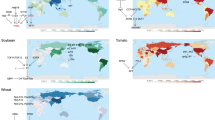Summary
In order to obtain high levels of environmental adaptability in wheat varieties it is essential they flower at times appropriate to particular environmental conditions. The influence of three distinct genetic systems that together determine time of flowering is reviewed here.
Vernalization genes are seen to be particularly important to winter wheats for their direct or indirect effects on winter hardiness. Vernalization genes play a minor role in determining flowering time in autumn sown winter wheats but insensitivity is essential if spring sown wheats are to flower.
Day length sensitive photoperiod genes play a major role in determining flowering time and adaptability of autumn sown wheats. Insensitivity can promote yield advantages of over 35% in Southern European environments. 15% in Central Europe and offers benefits even in the UK. At present only a single allele of Ppd1 appears to have been introduced into commercial European wheat varieties. The merits of alternative Ppd1 alleles or different loci are discussed.
The influence of earliness per se genes that determine flowering time independently of environmental stimuli is less well documented than the effect of photoperiod and vernalization genes. It is likely that genes on chromosomes belonging to groups 2, 3, 4, 6 and 7 may act to modify flowering time independently of environmental stimuli probably by determining numbers of vegetative and floral primordia being initiated or the rate of initiation of the primordia. Earliness per se genes appear to be widespread in European wheats and play a significant role in determining the exact time plants flower.
Similar content being viewed by others
References
Börner, A., A.J. Worland, J. Plaschke, E. Schumann & C.N. Law, 1993. Pleiotropic effects of genes for reduced height (Rht) and day length insensitivity (Ppd) on yield and its components for wheat grown in middle Europe. Plant Breeding 111: 204–216.
Devos, K.M. & M.D. Gale, 1993. The genetic maps of wheat and their potential in plant breeding. Outlook on Agriculture Vol. 22, No. 2: 93–99.
Faridi, N.I., 1988. Genetical studies of grain protein and developmental characters in wheat. Doctor of Philosophy dissertation, University of Cambridge, 1988.
Flood, R.G. & G.M. Halloran, 1983. The influence of certain chromosomes of the hexaploid wheat cultivar Thatcher on time to ear emergence in Chinese Spring. Euphytica 32: 121–124.
Gotoh, T., 1977. Varietal differences in photoperiodic and thermal responses of wheat. Jap. J. Breeding 27: 57–69 (Jap. E. summ.).
Hoogendoorn, C., 1985. A reciprocal F1 analysis of the genetic control of ear emergence, number of leaves and number of spikelets in wheat. Euphytica 34: 545–558.
Kosner, J., 1987. Intervarietal chromosome substitutions. European Wheat Aneuploid Newsletter 1987, pp. 9–10.
Law, C.N., 1966. The location of genetic factors affecting a quantitative character in wheat. Genetics 53: 487–498.
Law, C.N., 1987. The genetic control of daylength response in wheat. In: J.G. Averton (Ed.) Manipulation of Flowering. Butterworth & Co. pp. 225–240.
Law, C.N. & M.S. Wolfe, 1966. Location of genetic factors for mildew resistance and ear emergence on chromosome 7B of wheat. Can. J. Genet. Cytol. 8: 462–470.
Law, C.N., A.J. Worland & B. Giorgi, 1975. The genetic control of ear emergence time by chromosomes 5A and 5D of wheat. Heredity 36: 49–58.
Law, C.N., A.J. Worland & C.F. Young, 1980. Developmental studies in wheat using whole chromosome substitution lines. Proc. XIV International Congress of Genetics Vol. 1 Book 2: 282–294.
Lupton, F.G.H., 1992. Changes in varietal distribution of cereals in Central and Western Europe, Agro-ecological atlas of cereal growing in Europe. Vol. IV Pudoc. Wageningen, The Netherlands.
Maistrenko, 1980. Cytogenetic study of the growth habit and ear emergence time in wheat. In: Well Being of Mankind and Genetics. Proc. 14th Int. Cong. Genet. Vol. I Book 2: 267–282. MIR Publishers, Moscow.
Martinic, Z.F., 1975. Life cycle of common wheat varieties in natural environments as related to their response to shortened photoperiod. Z. Pflanzenzüchtg. 75: 237–251.
Miura, H. & A.J. Worland, 1994. Genetic control of vernalisation and day length responses and earliness per se by the homoeologous group 3 chromosomes in wheat. Plant Breeding 113: 160–169.
Scarth, R. & C.N. Law, 1983. The location of the photoperiod gene Ppd2 and an additional genetic factor for ear emergence time on chromosome 2B of wheat. Heredity 51: 607–619.
Sharp, P.J. & E. Soltes-Rak, 1988. Homoeologous relationships between wheat group 2 chromosome arms as determined by RFLP analysis. Proc. 7th Int. Wheat Genet. Symp. Cambridge: 635–637.
Strampelli, N., 1932. Early ripening wheats and the advance of Italian wheat production. Tipografia Failli, Rome pp. 5–7.
Sutka, J. & J.W. Snape, 1989. Location of a gene for frost resistance on chromosome 5A of wheat. Euphytica 42: 41–44.
Welsh, J.R., D.L. Klein, B. Pirasteh & R.D. Richards, 1973. Genetic control of photoperiod response in wheat. Proc. 4th Int. Wheat Genet. Symp. Missouri: 879–884.
Worland, A.J. & C.N. Law, 1985. Genetic analysis of chromosome 2D of wheat I. The location of genes affecting height, day length insensitivity and yellow rust resistance. Zeitschrift für Pflanzenzüchtung 96: 331–345.
Worland, A.J., S. Petrović & C.N. Law, 1988. Genetic analysis of chromosome 2D of wheat II. The importance of this chromosome to Yugoslavian varieties. Plant Breeding 100: 247–250.
Worland, A.J., M.L. Appendino & E.J. Sayers, 1994. The distribution of genes influencing ecoclimatic adaptability in European winter wheat varieties. Euphytica 80: 219–228.
Author information
Authors and Affiliations
Rights and permissions
About this article
Cite this article
Worland, A.J. The influence of flowering time genes on environmental adaptability in European wheats. Euphytica 89, 49–57 (1996). https://doi.org/10.1007/BF00015718
Issue Date:
DOI: https://doi.org/10.1007/BF00015718




